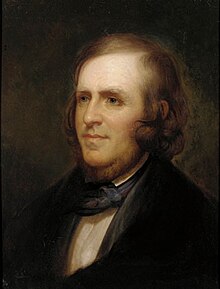Our website is made possible by displaying online advertisements to our visitors.
Please consider supporting us by disabling your ad blocker.
Franklin Peale
Franklin Peale | |
|---|---|
 Portrait by Rembrandt Peale | |
| 3rd Chief Coiner of the United States Mint at Philadelphia | |
| In office March 27, 1839 – December 2, 1854 | |
| President | |
| Preceded by | Adam Eckfeldt |
| Succeeded by | George K. Childs[1] |
| 2nd Melter and Refiner of the United States Mint at Philadelphia | |
| In office January 5, 1836 – March 27, 1839 | |
| President |
|
| Preceded by | Joseph Cloud |
| Succeeded by | Jonas R. McClintock |
| Personal details | |
| Born | Aldrovand Peale October 15, 1795 Philadelphia, Pennsylvania, U.S. |
| Died | May 5, 1870 (aged 74) Philadelphia, Pennsylvania, U.S. |
| Resting place | Laurel Hill Cemetery, Philadelphia[2] |
| Spouses | Eliza Greatrake
(m. 1815; ann. 1820)Caroline E. Girard Haslam
(m. 1839) |
| Children | 1 (by Greatrake) |
| Parent |
|
| Alma mater | University of Pennsylvania |
| Signature | |
Benjamin Franklin Peale (born Aldrovand Peale; October 15, 1795 – May 5, 1870) was an American officer of the Philadelphia Mint from 1833 to 1854. Although Peale introduced many innovations to the Mint of the United States, he was eventually dismissed amid allegations he had used his position for personal gain.
Peale was a son of painter Charles Willson Peale, and was born in the Philadelphia Museum, a museum of curiosities which his father ran in Philadelphia. For the most part, Franklin Peale's education was informal, though he took some classes at the University of Pennsylvania. He became adept in machine making. In 1820, he became an assistant to his father at the museum, and managed it after Charles Peale's death in 1827.
In 1833, Peale was hired by the Mint, and was sent for two years to Europe to study and report back on coining techniques. He returned with plans for improvement, and designed the first steam-powered coinage press in the United States, installed in 1836. Peale was made Melter and Refiner of the Philadelphia Mint that year, and Chief Coiner three years later upon the retirement of the incumbent, Adam Eckfeldt, who continued in his work without pay. Eckfeldt's labor allowed Peale to run a medal business using Mint property. This sideline eventually caused Peale's downfall: conflicts with Engraver James B. Longacre and Melter and Refiner Richard Sears McCulloh led to Peale being accused of misconduct, and he was dismissed by President Franklin Pierce in 1854.
In retirement, Peale continued his involvement in and leadership of many civic organizations; he died in 1870. Numismatic author Q. David Bowers suggests that the facts of Peale's career allow writers to draw very different conclusions about him.
- ^ United States Senate (1887). Journal of the Executive Proceedings of the Senate of the United States. Vol. IX. Washington, D.C.: United States Government Printing Office. p. 409.
- ^ "The Funeral of Franklin Peale". The Evening Bulletin. May 9, 1870. p. 8.
Previous Page Next Page


